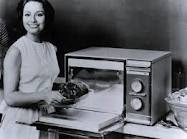“It is a sad reflection on our civilisation that we can, and do, measure the temperature of the atmosphere of Venus, yet we don’t know what goes on inside soufflés.”
The words in 1969 of physicist Professor Nicholas Kunti. I stumbled across them last week in the New Scientist edition of 3rd April of that year while looking up the canals of Mars in the British Library.
It seems the good professor enjoyed amongst his friends and closer acquaintances an enviable reputation as a bon viveur and cook. In furtherance of which, he proposed that physicists get together with the great chefs to invent a new cuisine for the microwave oven.
His own inventions included an inverted Baked Alaska : instead of ice cream surrounded by fruit, with meringue outside (the traditional arrangement), the prof had fruit inside, surrounded by meringue, with ice cream outside. 5 seconds in the microwave cooks the fruit from the inside mingling juices with the meringue, and leaving the ice cream on the outside cold.
He used a hypothermic syringe to inject pineapple juice into roasting pork.
And he devised a system for measuring and reading off the temperature inside a soufflé, fulfilling his ambition of placing this branch of haute cuisine on a par with the exploration of Venus.
 |
A happy housewife shows off the
Amana Radar Range microwave oven in 1967 |
The surprise to me was that they had microwave ovens so far back. An innovation I thought belonged to the 1980’s. But I find they were an accidental by-product of Second World War radar research.
 |
| Dr. Percy LeBaron Spencer |
Radar used magnetrons, these being vacuum tubes that produce microwave radiation (a type of electromagnetic radiation that has a wavelength between 1 mm and 30 cm). In 1946, the American engineer Dr. Percy LeBaron Spencer was working on magnetrons, and happened to have a candy bar in his pocket. He found it had melted, and linked this effect to the microwaves he was working with.
Experiments led him to the discovery that microwaves will cook foods faster than conventional ovens that cook with heat.
The Raytheon Corporation, his employer, produced the first commercial microwave oven in 1954. It was called the 1161 Radar Range. It was large, expensive, and had a power of 1600 watts. I have all this from the website of the
Southwest Museum of Engineering, Communication and Computation in Arizona, which has photos of the early monstrosities, and informs us that microwave ovens began to be used in home kitchens in 1967 when the first domestic model was produced by Amana (a division of Raytheon). This information is accompanied by the happy housewife illustration above.
I ought to add that the caption is mine not theirs.



